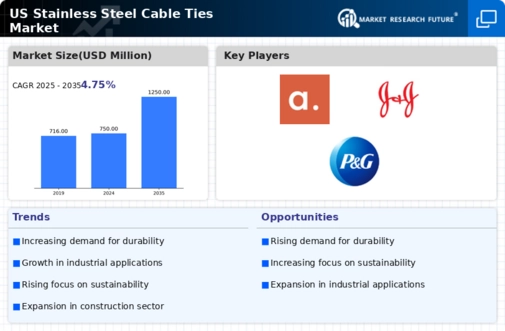The stainless steel-cable-ties market is characterized by a competitive landscape that is increasingly shaped by innovation, sustainability, and strategic partnerships. Key players such as Avery Dennison (US), HellermannTyton (DE), and 3M (US) are actively pursuing strategies that emphasize product differentiation and technological advancement. For instance, Avery Dennison (US) has focused on enhancing its product offerings through sustainable materials, which aligns with the growing demand for eco-friendly solutions. Meanwhile, HellermannTyton (DE) has been investing in digital transformation initiatives to streamline operations and improve customer engagement, thereby solidifying its market position. Collectively, these strategies contribute to a dynamic competitive environment where companies are not only vying for market share but also striving to meet evolving consumer expectations.
In terms of business tactics, localizing manufacturing and optimizing supply chains have emerged as critical strategies for companies operating in this market. The competitive structure appears moderately fragmented, with several players holding significant market shares while others focus on niche segments. This fragmentation allows for a diverse range of products and services, catering to various industries such as automotive, construction, and electronics. The collective influence of key players is substantial, as they leverage their operational efficiencies and innovative capabilities to maintain a competitive edge.
In October 2025, 3M (US) announced the launch of a new line of stainless steel cable ties designed specifically for high-temperature applications. This strategic move is significant as it addresses a specific market need, potentially capturing a larger share of the industrial sector that requires durable and heat-resistant fastening solutions. By expanding its product range, 3M (US) not only enhances its competitive positioning but also reinforces its commitment to innovation in response to customer demands.
In September 2025, Panduit (US) unveiled a partnership with a leading technology firm to integrate AI-driven analytics into its manufacturing processes. This collaboration is poised to enhance operational efficiency and product quality, reflecting a broader trend towards digitalization in the industry. The integration of AI technologies may enable Panduit (US) to optimize its supply chain and reduce lead times, thereby improving customer satisfaction and loyalty.
In August 2025, TE Connectivity (CH) expanded its manufacturing capabilities in the US by investing in a new facility dedicated to producing stainless steel cable ties. This expansion is indicative of a strategic focus on regional production, which not only reduces transportation costs but also allows for quicker response times to market demands. Such investments are likely to strengthen TE Connectivity's (CH) competitive position by enhancing its ability to serve local customers effectively.
As of November 2025, the competitive trends in the stainless steel-cable-ties market are increasingly defined by digitalization, sustainability, and the integration of advanced technologies. Strategic alliances are playing a pivotal role in shaping the current landscape, as companies seek to leverage complementary strengths to enhance their market offerings. Looking ahead, it appears that competitive differentiation will evolve from traditional price-based competition to a focus on innovation, technological advancements, and supply chain reliability. This shift may ultimately redefine how companies position themselves in the market, emphasizing the importance of adaptability and forward-thinking strategies.

















Leave a Comment